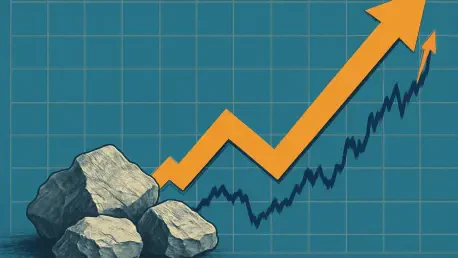In a market landscape increasingly defined by geopolitical tensions and resource scarcity, the rare earths sector has emerged as a battleground for economic and national security interests. Imagine a scenario where a single mining company’s stock skyrockets over 60% in a day, driven by whispers of U.S. government involvement, and you have the reality for Critical Metals (CRML.O), a firm central to Washington’s push to secure critical minerals. The surge, sparked by reports of potential government investment, underscores a pivotal moment for the industry as supply chain vulnerabilities and dependence on China take center stage. This analysis aims to dissect the market dynamics behind this remarkable uptick, exploring why such a deal matters and what it signals for investors and policymakers alike. By delving into trends, data, and projections, the focus will be on how this development shapes the broader critical minerals market.
Deep Dive into Market Trends and Strategic Developments
Stock Surge Drivers: U.S. Government Interest as a Catalyst
The dramatic 62% spike in Critical Metals shares on a single day in late 2024 reflects a potent mix of market optimism and strategic maneuvering. Reports of the U.S. government negotiating an equity stake—potentially converting a $50 million Defense Production Act grant into an 8% ownership—have fueled investor confidence. This isn’t merely speculation; it ties directly to the company’s ownership of the Tanbreez rare earth deposit in Greenland, a project billed as the largest of its kind in the region. With a year-to-date stock increase of over 91% and a valuation nearing $787 million at the last close, the market’s reaction signals strong belief in the firm’s role within a reshaped supply chain. However, lingering transparency issues, such as a recent restatement of financial statements for late 2023 and 2024, remind investors of underlying risks that could temper long-term enthusiasm if unresolved.
Geopolitical Stakes: Rare Earths as a National Priority
Beyond stock performance, the broader trend of U.S. involvement in critical minerals paints a picture of urgency. Rare earth elements, vital for electric vehicle batteries and defense technologies, are overwhelmingly controlled by China, which dominates over 80% of global production. This dependency has pushed Washington to prioritize diversified sourcing, with investments in firms like Lithium Americas and MP Materials serving as precedents. The focus on Greenland, a geopolitically significant Arctic territory, highlights a strategic intent to tap underdeveloped yet resource-rich regions. Market analysts note that such moves aim to establish a “mine-to-magnet” framework, reducing reliance on Chinese intermediation. Yet, challenges like harsh operating conditions and diplomatic complexities with Denmark, which oversees Greenland, could impact project timelines and costs.
Financial Backing and Industry Positioning
Adding to the bullish outlook, Critical Metals has secured $35 million from an unnamed institutional investor to advance the Tanbreez project, complementing potential government support. This financial momentum positions the company favorably against peers in the rare earths space, where early-stage ventures often struggle with funding. Compared to other mining investments, the firm’s trajectory suggests a high-growth opportunity, albeit with volatility typical of speculative assets. Industry data indicates that global demand for rare earths is projected to grow significantly by 2030, driven by clean energy and technology sectors. If negotiations with the U.S. government solidify, this could catalyze further capital inflows, potentially setting a benchmark for similar deals. Still, operational hurdles in the Arctic and environmental concerns remain critical variables in assessing long-term viability.
Emerging Patterns: Government-Backed Investments on the Rise
Looking at the wider market, a clear pattern of government-backed investments in critical minerals is taking shape. This isn’t an isolated event but part of a strategic push to support early-stage projects with high potential, spanning regions from Australia to Africa. Regulatory mechanisms, such as expanded Defense Production Act funding, are likely to accelerate over the next few years, with projections suggesting a doubling of such investments by 2027. Technological advancements in extraction and processing also promise to lower costs and mitigate environmental impacts, enhancing project feasibility. However, economic factors like inflation and geopolitical risks, including U.S.-China tensions, could constrain funding or shift priorities. The market is thus at a crossroads, balancing rapid action with sustainable and diplomatic considerations.
Reflecting on the Past: Strategic Lessons and Future Pathways
Looking back, the surge in Critical Metals shares marked a defining moment in the rare earths market, driven by U.S. government talks of a strategic stake in the Tanbreez project. The event highlighted the intersection of financial markets with national security imperatives, revealing how deeply intertwined resource access is with global power dynamics. Market reactions, financial backing, and geopolitical strategies converged to elevate the company’s profile, while also exposing risks tied to transparency and operational challenges.
Moving forward, stakeholders need to prioritize actionable strategies to capitalize on this momentum. For investors, a balanced approach is essential—monitoring negotiation outcomes while diversifying portfolios to hedge against volatility. Businesses in technology and defense sectors must advocate for policies that strengthen domestic supply chains, potentially partnering with government initiatives. Policymakers, meanwhile, face the task of aligning speed with sustainability, ensuring that international ventures respect local and environmental concerns. The path ahead demands collaboration and innovation to build a resilient critical minerals framework, setting the stage for a redefined industry landscape.









